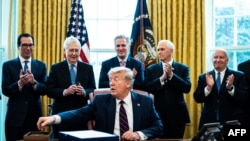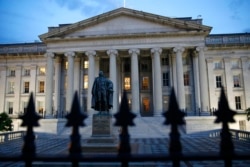Just days after Congress approved a record $2.2 trillion in emergency economic aid to offset the impact of the coronavirus pandemic, the Trump administration is racing to get the money out to hundreds of millions of Americans and millions of businesses reeling from the crisis.
The mega relief package is being hailed as a desperately needed measure to steady the teetering U.S. economy and to help many of the millions who have lost their jobs. But the sheer size of the aid program and the speed with which it is being doled out threatens to create a perfect storm for fraud and abuse on a magnitude not seen before, according to analysts.
Sprawling legislation
The sprawling legislation that was signed into law by U.S. President Donald Trump on Friday includes everything from massive loan programs for large and small businesses, direct payments to most families, aid to state and local governments, substantial increases in unemployment benefits and a bailout of airlines, hospitals and other major sectors of the economy.
Financial fraud experts, government watchdogs and investigators involved in past government probes dating back to the 2008 financial crisis warn that the cost of potential fraud and abuse this time around could easily run into the tens of billions of dollars.
Barry Sziklay, a veteran forensic accounting expert and a partner at Friedman LLP in New York, estimates that between 1% and 3% of the $2.2 trillion package could be lost through fraudulent activities.
Potentially $20 billion to $60 billion in fraud
“It would be between $20 billion and $60 billion,” Sziklay said. “That wouldn’t shock me. There will be billions of dollars lost by the time we’re done.”
Other experts agreed the extent of potential fraud will be significant. Howard Arp, director of investigations with the General Accountability Office, said there are scores of ways in which people could attempt to swindle or cheat the government economic stimulus program.
Plenty of opportunity for fraud
“Anytime you have a significant [spending] increase like this, there's always the opportunity for more people to take advantage of a program,” Arp said.
However, Arp and other experts note that with the U.S. in such desperate straits in battling the spread of a coronavirus that has already killed more than 3,400 people in this country, the billions lost to fraud may be a small price to pay as the government rushes to get desperately needed economic assistance to families and businesses.
“In a scenario like this, you sort of don't want perfect to be the enemy of good,” Arp said.
Marc Goldwein of the Committee for a Responsible Federal Budget, a government spending watchdog, said: "When Rome is burning you don’t worry about a couple of break-ins."
The GAO, an investigative arm of Congress, is expected to play an important role in the oversight of the coronavirus recovery program.
2008 relief spending
The economic relief package is unprecedented in size and scope. In the wake of the 2008 financial crisis, Congress created a $700 billion corporate bailout program known as TARP and subsequently a $787 billion economic stimulus package – for a total of more than $1.4 trillion.
The new law, known as the CARES Act, goes much further. In addition to offering direct cash payments of $1,200 and more to most Americans, it creates a $367 billion loan program for small businesses and a $500 billion rescue fund for large businesses and local governments.
Corporate rescue
Of particular concern to fraud experts is the structure of the new corporate rescue fund or "slush fund," as many call it. That’s because it will give Treasury Secretary Steven Mnuchin – a chief architect of the legislation - the same broad latitude with which former Treasury Secretary Henry “Hank” Paulson doled out funds under the controversial 2008 bailout program known as TARP.
$500 billion in loans and guarantees
Under the newly created financial support program, the Treasury Department can provide $500 billion in loans, loan guarantees and investments. That includes nearly $30 billion for airlines and cargo air carriers, $17 billion for national-security related companies and the rest for wide range of businesses, states and municipalities.
Democrats initially opposed the idea of the corporate rescue operation and acquiesced only after the White House agreed to the appointment of a special inspector general to investigate loans and investments made under the program. The law requires the inspector general to notify Congress if the administration withholds information or refuses to cooperate. But in a signing document Friday, Trump challenged the constitutionality of the mandate, raising concerns among experts about the future inspector general's independence.
New inspector general
“The signing document shows that the inspector general’s oversight impact may be neutered a bit by the president and the administration,” said Michael Rivera, a former chief investigative counsel for the TARP special inspector general and now a partner at the law firm of Bass, Berry & Sims in Washington. "The inspector general’s oversight can also be hampered if the administration interferes with the execution of its other duties and powers, including audits and investigations."
In addition to a special inspector general, the CARES Act calls for the establishment of a Pandemic Response and Accountability Committee to audit and investigate the program and a separate congressional commission to oversee decision-making over the funds.
A “belt and suspenders” approach
Sean Moulton of the non-partisan Project on Government Oversight said Congress took a “belt and suspenders” approach to the oversight of the stimulus package by bringing together so much investigative firepower.
"I am encouraged that we see some significant oversight in here, but I am also nervous," Moulton said. "We have never in a single action spent this much money and never in my lifetime has the money been so desperately needed."
A cottage industry of crooks
TARP’s relief programs for homeowners spawned a cottage industry of crooks, many of whom were later caught and sentenced to prison. In New York, a mortgage fraud ring tricked black and Latino homeowners into giving up their distressed properties. In Detroit, a city official was sentenced to 12 months in prison for taking bribes in connection with a demolition contract funded by TARP.
It wasn’t just small-time crooks who tried to rip off the government. Of the 300 people sentenced to date for charges brought by the TARP special inspector general, 76 were bankers, including chief executive officers, bank presidents, and chief financial officers at regional and community banks.
The assortment of bad actors seeking to exploit the coronavirus package could be just as varied, experts say.
“Trickle down relief”
Former federal prosecutor Laurel Loomis Rimon explained that the stimulus package is designed to produce trickle down relief through the economy, with large institutions receiving funding from the government and in turn providing loans to small-, mid-sized and large companies.
“You have all kinds of people thinking about applying for this potential aid on all different levels, so the pool of potential fraud or misconduct is pretty large,” said Rimon.
Rimon, now a partner at the O’Melveny & Myers law firm, played a leading role in federal prosecutions of mortgage fraud cases in California after the 2008 financial crisis.
Generally, two types of fraud are likely to occur under the program, predicted Rimon.
On the front end, prospective beneficiaries – whether jobless people or small business owners – might lie on their applications.
Financial institutions
On the back end, the scale of fraud involving financial institutions could potentially run higher. To inject liquidity into financial institutions, the Treasury Department will use part of the funds to buy financial securities backed by loans made to various private sector companies.
“If there are defects in the quality of those securities, as there were in the mortgage situation, you could have fraud cases against the government, in terms of selling those,” Rimon said.
Investigating those large cases can be time-consuming. But to the extent that there is fraud, there will also be recovery of funds, Sziklay said.
To date, investigations by the TARP special inspector general have resulted in the recovery of more than $11 billion, including $900 million in fiscal year 2019.









